Adrian Collins's Blog, page 138
May 8, 2022
REVIEW: Red Seas Under Red Skies by Scott Lynch
Scott Lynch’s second novel in The Gentlemen Bastards Sequence, Red Seas Under Red Skies, picks up two years after the events at the end of The Lies of Locke Lamora. A new city brings new opportunities and trials, forcing our boys to learn quite a few new tricks. More importantly, they’ll have to rehash some old ones.
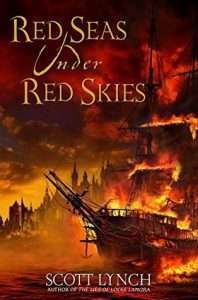 Red Seas Under Red Skies follows Locke and Jean after leaving their home in Camorr. Stuck in a deep spiral of despair, the only thing that can catch Locke’s attention is a challenge, the challenge of challenges: the Sinspire. The Sinspire is an infamous gambling house in the city state of Tal Verarr, revered for its high-class clientele, secrecy, and security. No one has ever stolen anything from the Sinspire and lived to tell the tale, making it the perfect target. There’s just one problem: before Locke and Jean can enact their deliberate and elaborate ruse, someone else requires their assistance of the most fatal kind. Led into a scheme on the high seas, our two favorite thieves will prove exactly how much they know about piracy and ships: absolutely nothing.
Red Seas Under Red Skies follows Locke and Jean after leaving their home in Camorr. Stuck in a deep spiral of despair, the only thing that can catch Locke’s attention is a challenge, the challenge of challenges: the Sinspire. The Sinspire is an infamous gambling house in the city state of Tal Verarr, revered for its high-class clientele, secrecy, and security. No one has ever stolen anything from the Sinspire and lived to tell the tale, making it the perfect target. There’s just one problem: before Locke and Jean can enact their deliberate and elaborate ruse, someone else requires their assistance of the most fatal kind. Led into a scheme on the high seas, our two favorite thieves will prove exactly how much they know about piracy and ships: absolutely nothing.
Although there is a time lapse between The Lies of Locke Lamora and Red Seas Under Red Skies, Lynch connects key moments from the past and the present, directly tying the books together. His prose continues to be a strength as he frames each story element from the mindset of a con man: every detail matters and creates a vivid image. The other highlight is the relationship dynamic between Locke and Jean. Where the first book set the foundation of the strong friendship between the two, the sequel shows the highs and lows that come with any meaningful relationship, especially during conflict. The level of effort Lynch puts into their bond invokes a strong sense of investment and care from the reader.
At over 600 pages, some readers might take issue with the pacing. This slow buildup combined with a large focus on a seemingly small plot point could form the mindset that Red Seas Under Red Skies is a jolly side quest. However, Lynch uses his unique affinity for master plotting to weave even the most miniscule of threads together, playing the reader just as Locke would a gullible mark. Everything comes together in the end. If anything, I wish there had been more pages to read when I finished.
From a grimdark perspective, Lynch uses his classic subtlety in Red Seas Under Red Skies. He lures you in with descriptions of food and stunning buildings before changing up the tempo with a quiet onslaught of brutality and truth: “The truth of anything we do will die with us and nobody else will ever have a bloody clue” (83). At surface level, this is not your typical blood and violence manifesto, but once you delve deeper, the book’s heart is just as black as other works found under the label, albeit shaped differently. I’m ready to see what awaits Locke next in The Republic of Thieves.
Read Red Seas Under Red Skies by Scott LynchThe post REVIEW: Red Seas Under Red Skies by Scott Lynch appeared first on Grimdark Magazine.
May 6, 2022
REVIEW: The Dragon’s Path by Daniel Abraham
The Dragon’s Path is an intriguing and character-focused fantasy release that helped me get out of a reading and review slump that has lasted 3-months.
The first entry in The Dagger and the Coin series, The Dragon’s Path mainly follows 4 point of view perspectives, 3 of which I really enjoyed reading. These main characters are Cithrin, an orphan bank ward, Marcus, a warrior of some renown, Geder, an upper-class intellect yet substandard soldier, and Dawson, a man of influence in one of the capital’s leading families, who is friends with the King and an expert dualist. The latter, the individual I’ve written the most about in that brief summary, is the character I enjoyed following the least, however; he was crucial in presenting the views of the upper echelon with the political unrest and turmoil brimming.
 Cithrin’s chapters were a joy to follow and some of the most unique. Through her, Abraham presents some really interesting moments where she ponders investments, banking, insurance, loans, and running businesses and it was engrossing. I personally have some experience in insurance and finance so found these parts pretty fascinating. Her progression and growth throughout is one of the novel’s highlights too.
Cithrin’s chapters were a joy to follow and some of the most unique. Through her, Abraham presents some really interesting moments where she ponders investments, banking, insurance, loans, and running businesses and it was engrossing. I personally have some experience in insurance and finance so found these parts pretty fascinating. Her progression and growth throughout is one of the novel’s highlights too.
If Cithrin represents the Coin of the series title, then I’d hesitate to guess that Marcus may be the Dagger. This is ambiguous at this point in the series though as there are many elements of mystery and conspiracies throughout this first entry. Returning to Marcus though, he’s got an illustrious past serving the military, has had family tragedy that haunts him, and seems to be a humble caravan guard captain at present. He’s sometimes brooding, intelligent, dangerous (whether this is shown or not in this novel I won’t divulge), and begrudgingly has a sense of duty and right in certain circumstances. His page time crossed over with another character frequently and their relationship is one of the main draws of this book to me. My assessment is that Marcus is destined to be massively important in the overall tale, and his relationship with another main character made me purchase the second and third books of the series before I was even halfway through The Dragon’s Path.
Like Marcus, Dawson’s point of view perspective crosses over with that of another main character, so, although I didn’t like reading Dawson’s views as much as the others, I’d estimate that a quarter of his page-time was through the eyes of another member of the ensemble, so I often forgot my minor irks with him. I’m not sure why I didn’t like him as much. Perhaps due to him being quite pompous and classist, he’s meant to be less likable. Whatever the case, he is still a fine character for this world and the story so far. It might be a frequent trait in multi-POV fantasy novels but I definitely have a soft spot for cross-over point of views, when as readers we can witness the same event and get two very different takes on it, (something John Gwynne does very well in The Faithful and the Fallen).
Geder’s tale in The Dragon’s Path is exquisite, bizarre, unpredictable, and kind of delightful! I don’t want to say too much about his story but I felt like I’d travelled half the map of this epic fantasy world with him, fully witnessing the highs and the lows that some major fantasy characters don’t see the like of in entire trilogies. I found him the most complex and rewarding so far.
The Dragon’s Path is firmly invested in fantasy, yet, in this novel, the extinct dragons, the heroes of old, the magic, and the gods are mainly just the lore and knowledge of the present-day characters. They aren’t showcased as being current and having any major influence on this finely crafted and well realised world. This novel focuses on the people, plots, struggles, hardships, wars, and courtly drama. I think that the otherworldly and strange powers that may be lurking in the shadows of the sidelines will take centre stage in the subsequent novels. If so, I’m interested to see how the stakes change and the effects it has on the characters I’ve very much enjoyed following here.
Another element I’ll quickly discuss is that I love fantasy reads with complex and unique magic systems, where I can try to figure them out and understand the rules. Magic such as this isn’t present in The Dagger and the Coin yet, but the possibilities are hinted at and I await with bated breath if more is revealed in The King’s Blood.
The Dragon’s Path dragged me out of my reading slump where many other highly rated fantasy books failed. I will score it a 7.5/10 which is down to my overall enjoyment, how neatly the stories wrapped up, and I am excited by the potential that is shown here and how promisingly it sets up the series. Abraham seems to be a fine writer, this novel presents good plotting and pacing, fine main characters, and a few gems in the second tier. The Dragon’s Path also features a well-worked mixture of both action scenes and gripping dialogue moments. I took a chance on a series that I knew little about, and am content that I did. The Dragon’s Path, although not quite brilliant, did reinvigorate my passion for reading. As much of that is down to what could come next, on top of what was featured here.
Read The Dragon’s Path by Daniel AbrahamThe post REVIEW: The Dragon’s Path by Daniel Abraham appeared first on Grimdark Magazine.
May 5, 2022
REVIEW: The Roach by Rhett C. Bruno
The Roach by Rhett C. Bruno is a book that is a rare find among grimdark fiction: a superhero novel. There’s certainly grimdark superhero stories like Watchmen, The Dark Knight Returns, Spawn, and Daredevil: Born Again. However, the literary superhero is more inclined to be zany comedy than a somber reflection of the dark side of superherodom. I don’t say that just because I write zany superhero comedy.
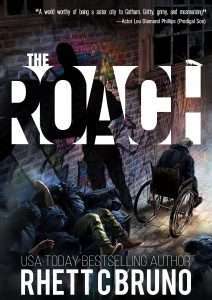 Reese Roberts is a wheelchair-bound man contemplating ending it all by drowning himself in Iron Heights’ river at the start of the book. This is already darker territory than the majority of superheroes take the subject. Reese used to be the Roach, the most feared man in the city and something resembling a superhero. I say something resembling because several people rightfully (?) point out that he could easily be referred to as a serial killer instead.
Reese Roberts is a wheelchair-bound man contemplating ending it all by drowning himself in Iron Heights’ river at the start of the book. This is already darker territory than the majority of superheroes take the subject. Reese used to be the Roach, the most feared man in the city and something resembling a superhero. I say something resembling because several people rightfully (?) point out that he could easily be referred to as a serial killer instead.
The Roach ended his career by interrupting a rape and getting shot in the process. Thankfully, for him, the woman was the daughter of a local politician who proceeded to clean up after him. The city is now no longer the same sort of hellhole it used to be. However, it’s still left Reese purposeless and hounded by the single lone reporter who wants to expose him for all of his crimes.
Part of what makes the story interesting is that the Roach is clearly crazy. He’s much closer to Rorschach and the Punisher than Batman. When people call him a serial killer, they’re not wrong as he was driven by a brutal desire to deal out as much punishment as he could and many of his his victims are people that could have escaped their circumstances to be better people.
The book deals with the kind of circumstances that would make a murderous vigilante and gets into his head. Reese’s mind is an ugly place to be and full of hate for just about everyone and everything. The only people he doesn’t bear any animus toward is the woman he rescued as well as her young daughter. Everyone else he holds in a state of utter contempt.
This is a dark and gritty book that doesn’t contain much in the way of superhero tropes except for the Roach himself. He has a bullet proof costume (that failed him), a lair, and a lot of skill as both a detective as well as fighter.However, the rest of the city is full of ordinary criminals and heinous crime that verges on Sin City levels of corrupt.Perhaps too much as it plays into the idea the Roach may well be right about his city.
Are there perhaps too few coincidences in the story? Yes. But compared to your average superhero story, it’s the height of realism. There’s no supervillains in this world but at least one baddie is portrayed as all but indestructible to cops and security despite the fact he’s been in a mental hospital for years. Something that should have left him less capable of inflicting damage rather than more. These are all necessary beats for a good superhero story, though, so I won’t complain too much.
Rhett C. Bruno has a gift for action and his descriptions of the violence that is inflicted by our hero as well as on our hero is extremely well done. This contains a lot of dark and heavy subject matter but the fact it’s a superhero book makes the effect all the more surreal. I was very impressed with the story from beginning to end. If you’re looking for a genuinely grimdark superhero tale then this is the book for you.
Read The Roach by Rhett C. BrunoThe post REVIEW: The Roach by Rhett C. Bruno appeared first on Grimdark Magazine.
May 4, 2022
REVIEW: The Lawless Land by Boyd and Beth Morrison
The Lawless Land by Beth and Boyd Morrison is a historical fiction that will have medieval action fans on the edge of their seats. Set in a post-ish Black Death England and France, The Lawless Land is what you get when you put Jack Reacher into a medieval setting (according to Lee Child, who I can’t disagree with here!). It’s a badarse book and easy reading.
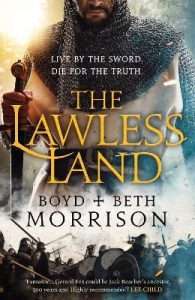 In The Lawless Land, Gerard Fox, roaming ex-communicated knight and man at arms for hire, witnesses a daring lady fleeing in a crossbow bolt-prickled carriage. Stepping in with recurve bow and blade, he inadvertently throws away his life plans and launches himself into bloody adventure alongside Lady Isabel.
In The Lawless Land, Gerard Fox, roaming ex-communicated knight and man at arms for hire, witnesses a daring lady fleeing in a crossbow bolt-prickled carriage. Stepping in with recurve bow and blade, he inadvertently throws away his life plans and launches himself into bloody adventure alongside Lady Isabel.
Lady Isabel carries a secret protected by the women of her family line for centuries, but in fleeing the horrible grasp of her betrothed, she flings herself into the wild of a land stricken with the Black Plague, criminals, brigands, and an incredibly angry, vengeful, and spiteful husband to be.
Around our two main characters are the supporting cast: Lord Tonbridge is fuming at the loss of his bride-to-be and the impact on his future plans to rule, the corrupt Cardinal Molyneux chases the final step to the papacy, and Basquin the bastard craves freedom from under his father’s brutal heel.
The authors have interlinked the storylines of The Lawless Land nicely, and created an easy to follow web of twists and turns. They also know how to pull off a big scene and as we got in to the last 30% of the book The Lawless Land really picked up speed and I found it harder and harder to put down. The sheer attention to detail, and creative extrapolation where detail of certain things in the 14th century perhaps didn’t exists is amazing. In addition to the research both authors must have thrown themselves into, all of Beth Morrison’s experience as the curator of the Department of Manuscripts at the J. Paul Getty museum shows through here, as does both authors’ experiences travelling Europe.
However, there was one key thing that didn’t land with me. In the first half of The Lawless Land especially, the conversations between characters felt stilted. While I imagine the intended effect was to get me into the medieval mood, the result was to create a struggle in flow and conversations that felt a bit like bad acting, and therefore I didn’t really feel a bond of brotherhood between Fox and his associates as their banter trudged and tripped along.
As far as grimdark characters go, Basquin, Molyneux, and Tonbridge’s POVs provide the closest to what we love reading here at Grimdark Magazine. However, their characters never really cross the bridge from just being nasty for the sake of it, to having the reader relate to them in any way. Basquain probably gets the closest, but I never really got enough to form an emotional attachment to him so that when something didn’t go his way I would feel for him. When about a third of the book is made up of their scenes and chapters, it really means you’re just rooting for their deaths, and not really understanding them, making the villains a bit one dimensional rather than enjoyable reads for this reviewer.
The Lawless Land is a fun easy read, and will delight medieval action and adventure aficionados and fans. The lack of an emotional attachment to the POVs of approximately a third of the book is problematic for me, but if you love a good old fashioned evil villains doing evil things, then you’ll absolutely love this book.
3/5
Read The Lawless Land by Boyd and Beth MorrisonThe post REVIEW: The Lawless Land by Boyd and Beth Morrison appeared first on Grimdark Magazine.
May 3, 2022
REVIEW: Deepwater King by Claire McKenna
My personal comfort place is by a wild coast, listening to the sea bashing against rocks. The wildness of it, the vast presence of the water and the rough saltiness of the sea air have been singing their siren song to me since I was little. So when I was pitched a review copy of Claire McKenna’s Deepwater King, a gothic fantasy set at sea with steampunk influences, I knew there was no way I could resist its call. This is the second book in McKenna’s Deepwater Trilogy, following up on Monstrous Heart. The series will end with Firetide Coast in Summer 2022, so there isn’t long to wait to be able to binge the entire trilogy in a single sitting. And they’re so much fun you may want to do just that. Mixing elements of a gothic steampunk setting, which dominated the first book with an almost pirate-like sea adventure makes for great entertainment, and the series’ leading lady, Arden, is a strong lead character.
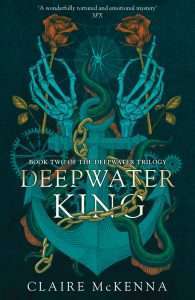 Not concerned with being pleasant or likeable, she is determined and smart, though not infallible or overpowered. She is a grown woman, one with flaws and strengths. And most of all, she is passionate, and cares about the people around her. The series is billed as a romantic fantasy, though I found that the focus wasn’t laid overly much on the romance aspect, which I appreciated. Love and relationships, both romantic and platonic, do form a core element of the story, but ultimately, it felt like the books were more focused on sacrifice and how far the characters were willing to go for those they cared about. This was also underlined by distance, as much of the romantic tension within the story took place through written communication.
Not concerned with being pleasant or likeable, she is determined and smart, though not infallible or overpowered. She is a grown woman, one with flaws and strengths. And most of all, she is passionate, and cares about the people around her. The series is billed as a romantic fantasy, though I found that the focus wasn’t laid overly much on the romance aspect, which I appreciated. Love and relationships, both romantic and platonic, do form a core element of the story, but ultimately, it felt like the books were more focused on sacrifice and how far the characters were willing to go for those they cared about. This was also underlined by distance, as much of the romantic tension within the story took place through written communication.
What helped make these books compelling to me was the worldbuilding. It is not an epic secondary world or a grand-scale reinvention, but it is solid and coherent, and it draws the reader in. It is made clear that there is a much more expansive world and mythology to go along with than what the reader sees at first glance, making it appear real and plastic. And so Arden’s story becomes a wonderfully comforting read. One that mirrors the comfort given to be by sitting at the coast, listening to the rough sea. Deepwater King (and Monstrous Heart) are books that resonated a lot with me, and I hope Firetide Coast will too. If water is your element as much as it is mine, and you enjoy dark, gothic, stories with a touch of romance, do give these a chance, as I think they have flown under the radar and deserve more attention.
Read Deepwater King by Claire McKennaThe post REVIEW: Deepwater King by Claire McKenna appeared first on Grimdark Magazine.
May 2, 2022
REVIEW: This Thing of Darkness by Allan Batchelder
“What if William Shakespeare faked his death to live in Jamestown? What if there was a monster in the woods there?” Either of these could be the basis for a fun alternate history novel but combined have a very quirky and interesting story. The fact This Thing of Darkness is being reviewed in Grimdark Magazine should tell you that the results are a bit on the darker side, though. Allan Batchelder is the author of the excellent Immortal Treachery fantasy series, and I was thus interested in seeing what he came up with in his latest standalone.
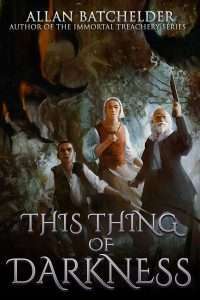 The premise is “William Kemp” has come to Jamestown under mysterious circumstances and almost immediately makes several enemies from the local released criminals as well as his general attitude. His worldliness, irreligiosity (mild by our time, scandalous then), arrogance, and secretiveness put off just about everyone else in the colony. Thankfully, he befriends a young boy named Xander and a woman named Margaret that provide him at least some respite from his ill-conceived plan to start over.
The premise is “William Kemp” has come to Jamestown under mysterious circumstances and almost immediately makes several enemies from the local released criminals as well as his general attitude. His worldliness, irreligiosity (mild by our time, scandalous then), arrogance, and secretiveness put off just about everyone else in the colony. Thankfully, he befriends a young boy named Xander and a woman named Margaret that provide him at least some respite from his ill-conceived plan to start over.
Unfortunately, as mentioned above, William has come to a period in Jamestown history unknown to the modern world: when the colony is menaced by an unknown cannibalistic monster. William is aware he may be letting his prodigious imagination run away with him when there are more mundane explanations possible, but the New World is a frightening as well as alien place. It doesn’t help the local law has a vested interest in blaming either the local tribes or animal attacks lest they scare off potential new settlers.
I really must give Allan Batchelder credit for doing his research as the Bard on page feels plausibly like the kind of man who penned both Hamlet as well as The Merchant of Venice. He is a witty but somewhat sad man who has a lifetime of regrets starting with abandoning his wife as well as more than a few checkered romances that ended badly. Most of the latter are also based on Shakespearian scholarship too and are more interesting than you might think given the premise of “Elizabethan Shakespearian romance.” William is a poor detective either way and wants nothing more than the problem to go away as well as his issues with the locals that are becoming increasingly likely to end in violence. However, the circumstances come to a head when one of his few companions ends up vanishing and no one but he is interested in doing anything about it. It is not a heroic story and William’s poor capacity for heroism makes him an engaging protagonist.
This Thing of Darkness is a solid and entertaining work of fiction that I think people who don’t much care for historical fantasy will enjoy or, heck, even Shakespeare. If you like good characterization and an engaging plot then this will satisfy you.
Read This Thing of Darkness by Allan BatchelderThe post REVIEW: This Thing of Darkness by Allan Batchelder appeared first on Grimdark Magazine.
May 1, 2022
REVIEW: Stringers by Chris Panatier
Ben Sullivan, the lead protagonist of Stringers, Chris Panatier’s new novel, has a skewed view of the world. Imagine having a mind chockful of useless information, information that has somehow inexplicably been there your whole life. Add in heaping loads of social awkwardness, and you have Ben. His whole life has been full of oppressive details about the mating habits of animals, exotic watches, fly lure creation, and not much else.
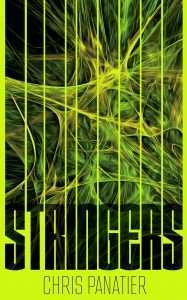 We start our story with Ben at work making an exotic and beautiful fly lure, and he is being accosted by a customer Jim. Jim would like “oneuh them boom trains then.” Ben reminds Jim that he can have one of them boom trains flys for some cold hard currency. We segway from the current conversation into the mating habit of moles, dolphins, and porcupines. This intrusiveness of thoughts permeates every waking moment for Ben. His life is one constant battle against animal sex lives, watches, and fly lures.
We start our story with Ben at work making an exotic and beautiful fly lure, and he is being accosted by a customer Jim. Jim would like “oneuh them boom trains then.” Ben reminds Jim that he can have one of them boom trains flys for some cold hard currency. We segway from the current conversation into the mating habit of moles, dolphins, and porcupines. This intrusiveness of thoughts permeates every waking moment for Ben. His life is one constant battle against animal sex lives, watches, and fly lures.
Ben’s desperation is apparent. Anyone would be desperate to escape the constant thoughts of seemingly banal information. From a character perspective, I think Panatier did a great job with Ben. Ben is more than his quirks, but his battle with his quirks defines who he is out in the world.
Now, we segway to a scene between Ben and his “Samwise Gamgee,” Patton. Patton is a screwup, an often drugged kid in an adult’s body who never could grow up. He is also fiercely loyal. We should all be so lucky to have the caliber of friend that Patton is.
In a moment of desperation and curiosity, Ben finds another person in an online group who has the same intrusive thought problems as he does. At this point, Ben is reaching out for anything that will make his life better. Patton fears that Ben will be made into a skin vest or something of that ilk and demands that he comes along. He is always trying to protect his friend.
One thing leads to another, and aliens abduct both Patton and Ben. Now the real adventure starts.
This story’s blurb proclaims it to be a bit like Hitchhikers Guide to the Galaxy, except instead of towels, the friends are armed with a giant container of pickles and whatever wits the two of them can scrape up together. There is kidnapping, aliens bent on destruction, drugs, and mind-bending machines. It asks the question, “What is a Stringer?” Stringers isn’t all fun and games though, there are some very dark moments and some rather introspective thoughts on friendship that balance out the levity. Generally, Stringers is an amusing story. It wasn’t “side stitch” funny but undoubtedly funny enough to see how each ridiculous predicament rolled into the next.
I also loved how Panatier described space and aliens. It wasn’t hard science fiction, but just enough details, especially about what a stringer actually is, to make my science fiction-loving heart happy. And to top it off, Panatier nailed the ending. None of which I can talk about for fear of giving anything away.
All and all, this is one of my favorite science fiction reads so far this year. So much so that I will check out Panatier’s The Phlebotomist. I am in for a treat if the writing is anywhere near as fun as this is.
Read Stringers by Chris PanatierThe post REVIEW: Stringers by Chris Panatier appeared first on Grimdark Magazine.
April 30, 2022
REVIEW: Nettle and Bone by T. Kingfisher
T. Kingfisher is a Hugo and Nebula Award winning author, and Nettle and Bone is her latest deliciously dark adult fantasy offering. Nettle and Bone is a standalone novel, expanding on of the world and some of the characters that Kingfisher first introduced many years ago in the short story Godmother. I am very grateful to both Titan and T. Kingfisher for sending me an advanced reader copy of Nettle and Bone to be able to review it for Grimdark Magazine.
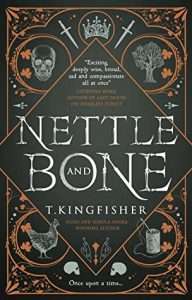 Before I begin my review, I would like to provide a content warning to readers – this novel contains depictions of abusive relationships and references to miscarriage. These events are important to the plot and dealt with sensitively by T. Kingfisher. They are not described in graphic or explicit detail.
Before I begin my review, I would like to provide a content warning to readers – this novel contains depictions of abusive relationships and references to miscarriage. These events are important to the plot and dealt with sensitively by T. Kingfisher. They are not described in graphic or explicit detail.
Nettle and Bone is a gorgeously written dark fantasy. It is not a retelling of a typical fairy tale, but there are clear fairy tale traits such as the godmother, the prince and the near impossible heroic quest. Even though Kingfisher is dealing with some very dark themes she does so in a delicate and charming way. It is a witty and darkly humorous story and I loved that Kingfisher is focussing on the characters who are usually bit parts in the fairy tale genre. Nettle and Bone is a really enjoyable well-paced read and I think fans of Christina Henry, Alexis Henderson, or Alix E. Harrow would find it a wonderful addition to their book shelves.
The main character of Nettle and Bone is Marra, a thirty year old minor royal of a minor royal house. Marra has spent much of her life quietly secluded in a convent far away from the machinations of mainstream royal life and admits she is more of a nun than a princess. It takes her many years to realise that her sisters were (or are still) trapped in violent and loveless marriages to an abusive prince, so shy and reserved Marra vows to kill him to protect her family. She just does not have any idea how she is going to be able to succeed in that task. Nettle and Bone’s opening chapter shows Marra digging through a charnel pit with her bare and bleeding hands to gather bones to thread together with wire and build a bone dog. This opening is delightful and creepy in equal measures and Marra is such a likeable protagonist that I was instantly emotionally invested in her and because of this, her quest. Although as a fairy tale there are some expected tropes used, Kingfisher has created a stunning puzzle of an original story. A reader might recognise certain pieces but how they fit together and what the finished creation will look like is a mystery, which makes Nettle and Bone an exceptionally good read.
Kingfisher’s ensemble cast at first glance looks like a rag tag bunch of misfits. It has naïve Marra, along with a grumpy dust witch, a ditzy godmother, a diplomatic former knight, and the animal sidekicks of Bonedog, a cursed chick, and a demon possessed chicken. They are heart-warmingly well written and their journey is very detailed and well developed given that the novel is only just over three hundred pages. It is extraordinarily impressive that Kingfisher has navigated a dark and troubling world in such a skilled and nuanced manner. She has created in Nettle and Bone a twisted mix of morbid horror and sweet delight which somehow works unexpectedly well. How a story inspired by the ickier side to fairy stories (which Kingfisher explores in her author’s note at the end of the novel) can leave a reader with such warm fuzzy feelings at the end is an impressive feat. I am so disappointed that Nettle and Bone is a standalone piece and I really hope that T. Kingfisher choses to return to this world, if not these characters, because there is scope for so much more and I for one would love to read it.
4/5
Read Nettle and Bone by T. KingfisherThe post REVIEW: Nettle and Bone by T. Kingfisher appeared first on Grimdark Magazine.
April 29, 2022
REVIEW: Sweet Home
Based on a popular webtoon, Sweet Home is another post-apocalyptic Korean drama currently on Netflix. A group of disparate residents are holed up in a grungy apartment complex as humans begin to turn into savage monsters around them. Forced to band together, they fight back against the monsters as they try to survive and find out what has happened.
 Similar to shows such as All of us are Dead and the always popular The Walking Dead, Sweet Home is all about looking at how humans cope in dangerous, dire situations and seeing whether they can hold onto their humanity. Swapping zombies for increasingly strange and odd monsters adds a freshness to the genre but as always, it is the connection between the characters that holds the audience for the ten episodes of the series. Young Cha Hyun-soo is suicidal. He goes to jump off from a roof when he is distracted by another resident. All hell soon breaks loose as monsters begin tearing through the city and the complex and suddenly Hyun-soo has something to else to distract him for his planned suicide. Sweet Home slowly introduces us to the myriad of characters living in the apartments, both good and bad. The characters are generally fleshed out quite well with a few twists to shock and keep you guessing. The characters evolve throughout the series with most growing closer as the danger increases and they get to know one another better.
Similar to shows such as All of us are Dead and the always popular The Walking Dead, Sweet Home is all about looking at how humans cope in dangerous, dire situations and seeing whether they can hold onto their humanity. Swapping zombies for increasingly strange and odd monsters adds a freshness to the genre but as always, it is the connection between the characters that holds the audience for the ten episodes of the series. Young Cha Hyun-soo is suicidal. He goes to jump off from a roof when he is distracted by another resident. All hell soon breaks loose as monsters begin tearing through the city and the complex and suddenly Hyun-soo has something to else to distract him for his planned suicide. Sweet Home slowly introduces us to the myriad of characters living in the apartments, both good and bad. The characters are generally fleshed out quite well with a few twists to shock and keep you guessing. The characters evolve throughout the series with most growing closer as the danger increases and they get to know one another better.
The CGI isn’t great, giving off more of a stop motion vibe than most modern series but this isn’t something that holds Sweet Home back. There is gore aplenty as the residents fight back against the growing horde of unique monsters and the only thing that manages to pull the viewer from the suspense and drama is an overuse of Imagine Dragons for the soundtrack. Thankfully, the interactions between the characters are strong. There is a good mix of drama and comedy, similar to what worked on All of us are Dead. There are quite a few threads throughout the story due to the number of residents but the writing I strong enough to carry the story and make you care about the majority of them. You’ll have your favourites and be praying that they survive the chaos.
While it doesn’t reinvent the wheel, Sweet Home is an enjoyable apocalyptic drama full of interesting characters and memorable monsters. It’s definitely worth a watch if you are enjoying the rise of Korean horror at the moment even if you aren’t going to be waiting with bated breath for a second season.
The post REVIEW: Sweet Home appeared first on Grimdark Magazine.
April 28, 2022
An Interview With Ben Aaronovitch
Years ago, on my quest to read the world of urban fantasy, I came across Bestselling urban fantasy author Ben Aaronovitch’s Rivers of London novels and was immediately hooked.
Ben kindly sat down with us and chatted with us about writing, his start, and his newest novel, Amongst Our Weapons.
 [GdM] How did you become a novelist? Can you tell us about Waterstones and how Rivers of London come about?
[GdM] How did you become a novelist? Can you tell us about Waterstones and how Rivers of London come about?
I started as a script writer but after my first Doctor Who I was offered the chance to novelise my story which is like someone saying they’ll pay you good money to learn how to write prose. Once I’d done a 40,000 word novella I knew I could do a full length book. After a few more tie in novels for Virgin and Big Finish I was confident I could write well to that format. When my career as a scriptwriter fizzled out I found myself working in Waterstones and going slowly bankrupt. Faced with penury or worse- moving out of London, I turned to prose to make my one and only talent, writing, pay. The question was – what kind of novel would I write?
[GdM] You said in an interview that you had an epiphanic moment for who Peter Grant is. Can you tell us about that moment?
After casting about and reviewing old ideas I settled on a crime/fantasy hybrid that I’d been developing as a TV pitch before common sense caught up with me and I recognised that no British TV company was going to make it. But the beauty of writing a novel is that in the first instance you are writing for just one person – yourself. Thus Magic Cops(w/t) was resurrected as a prose project and I started thinking about a protagonist. I knew he was a Londoner and I knew he was mixed race and a police officer but that was it.
Then into my mind came Peter Grant, jazz junkie father and Sierra Leonean mother and all. I knew where he lived, where he’d gone to school and how he came to join the police. More importantly I sat down and wrote what become the first five pages of Rivers of London. Peter’s voice came alive and at that moment I knew I’d got hold of something that would sell. I just had to write the next 90,000 words…plus come up with a plot.
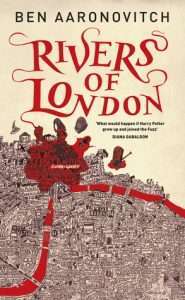 [GdM] I watched a video where you said, “my life was saved by a PCW in my early 20s.” How did a PCW save you?
[GdM] I watched a video where you said, “my life was saved by a PCW in my early 20s.” How did a PCW save you?
I’m a terrible speller and a fast but inaccurate typist. The Amstrad PCW was the first affordable word processor to come on the market in the UK. It ran a WP called Locoscript and immediately I had access to onscreen editing and, most importantly, a spell checker. This allowed me to write my first scripts and novels and thus saved my life from the misery of having to work for a living.
[GdM] London is your hometown, and you have a deep connection to it. What are the positives and negatives you have run into depicting it as the setting for Peter Grant’s Rivers of London?
Well the positives are obvious because I know the city very well I know where all the good locations are going to be. That’s especially important when you’re trying to write a novel at 4:00 o’clock in the morning which you have to if you already holding down a full time job and have a teenage son. From my point of view there aren’t any real negatives except that some people seem to have something against London, I don’t know why, go figure.
[GdM] In the US, the first book of the series is Midnight Riot instead of Rivers of London. Why is that?
American publishers often localize the titles of British books and vice versa although in my case this was a mistake. In the far off days of twenty years ago far less publicity and word of mouth was generated via social media. Markets tended to be much more self-contained and so changing the title had little effect. I think changing the title meant that Midnight Riot failed to gain from the social media momentum generated by the UK release which partly explains its lacklustre performance – plus the bloody awful US cover didn’t help.
[GdM] Can you tell us a bit about October Man? Where did the idea for Tobias Winter come about?
Tobias Winter came about when I wrote a very short piece, what I call a moment, just for fun, where we discovered just what the German reaction was to Peter Grant being made an apprentice. That introduced Tobias Winter and his boss. The trouble is when you create a character like that they demand to have their own stories told and since I couldn’t get him over to London I had to write a story set in Germany.
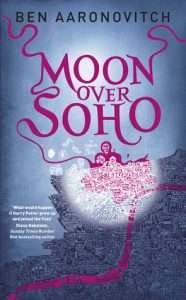 [GdM] How do you handle your research for each novel? Are there any enjoyable rabbit holes you went down that have not ended up in the series thus far but still might in the future?
[GdM] How do you handle your research for each novel? Are there any enjoyable rabbit holes you went down that have not ended up in the series thus far but still might in the future?
Research is essentially finding as many rabbit holes as you can and then attempting to go down the maximum number within the time you’ve allowed yourself, You’re constantly finding new and interesting stuff but at some point you have to stop and start writing.
[GdM] Did you read or play D&D as a youth, or were you a big reader? If so, what was your gateway book into SFF?
Yes I did, in fact I once owned, aged 12, the original three book box set that spawned a million house rules. I played a lot in my teens but like many people I suffered a shortage of people to play with and besides, creating the worlds is what really excited me. I prefer non-class based systems such as BRP and Traveller so I gravitated to such games as Call of Cthulhu.
[GdM] You have a new addition to the Rivers of London series in Amongst Our Weapons. Can you tell us a bit about where we are in the story?
Well just to clarify Rivers of London was never conceived as a series with a beginning, a middle and an end. Instead I was aiming much more at the classic detective mode as seen in Ed McBain’s 87th Precinct series, Ian Rankin’s Rebus books or, more classically, Agatha Christie’s Poirot. But unless you reset your detective after every mystery there is going to be character and setting change and growth with each instalment. Since Amongst Our Weapons is the ninth full length novel things have moved on since PC Peter Grant tried to take a witness statement from a ghost one cold January night in Covent Garden,
For a start Peter is now a dangerous wizard in his own right with a growing reputation amongst the demi-monde and his fellow police officers. He is also about to become a father for the first time and since his partner is Beverley Brook, the goddess of a small river in South London, this is binding him tighter to the world of the supernatural.
In the meantime he has helped take the Folly, a moribund institution and dragged it, if not kicking and screaming then certainly grumbling under its breath into the world of 21st Century professionalised policing. Which is just as well because magic, long thought dormant, is bubbling up to the surface bringing with it fresh new challenges. One of these challenges being a dead body in the London Silver Vaults with a hole in its chest where its heart should be.
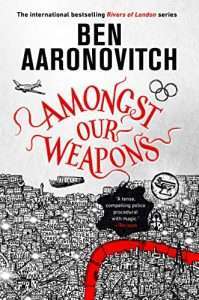 [GdM] Is the process of writing a novel for the Rivers of London series different now at book 9+ than it was for your first book, Rivers of London?
[GdM] Is the process of writing a novel for the Rivers of London series different now at book 9+ than it was for your first book, Rivers of London?
You know I keep expecting it to get easier but the process is just as laborious now as it was with the first book. Fortunately it’s still as much fun as it was when I started so I don’t mind so much. I have more mental “tools” to deal with blockages and the like and I have the certainty that what I write will eventually be published which is nice.
[GdM] There is another famous Peter Grant, the manager for Led Zeppelin. Is it a coincidence that they share the same name, or are you a Zeppelin fan?
That’s a total coincidence I was merely going for an ordinary anodyne name like Harry Palmer or James Bond (before he got famous). Given the fantastical nature of the world he was entering I didn’t want to call him ridiculous like Dan Spectre or Max Steel.
[GdM] Are you working on the release of the next graphic novel book for Rivers of London?
The latest graphic novel is under production even as we speak.
[GdM] Is there any news on Simon Pegg & Nick Frost’s Stolen Picture adaption?
Alas no. The TV adaptation is still in the same state of permanent pre-pre-production it has been in for the last 11 years.
Read Amongst Our Weapons by Ben AaronovichThe post An Interview With Ben Aaronovitch appeared first on Grimdark Magazine.



